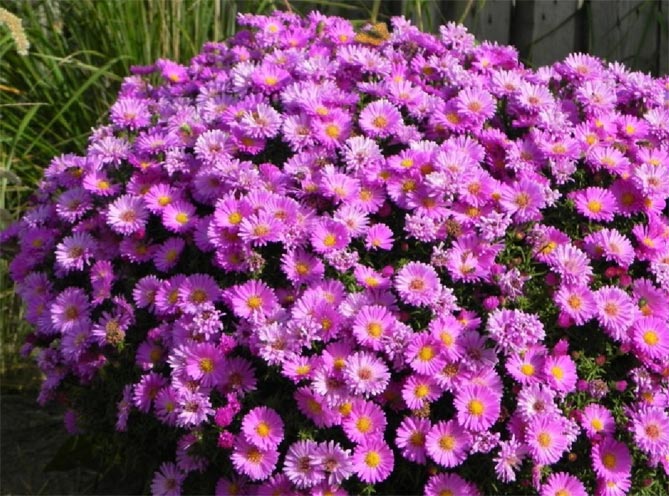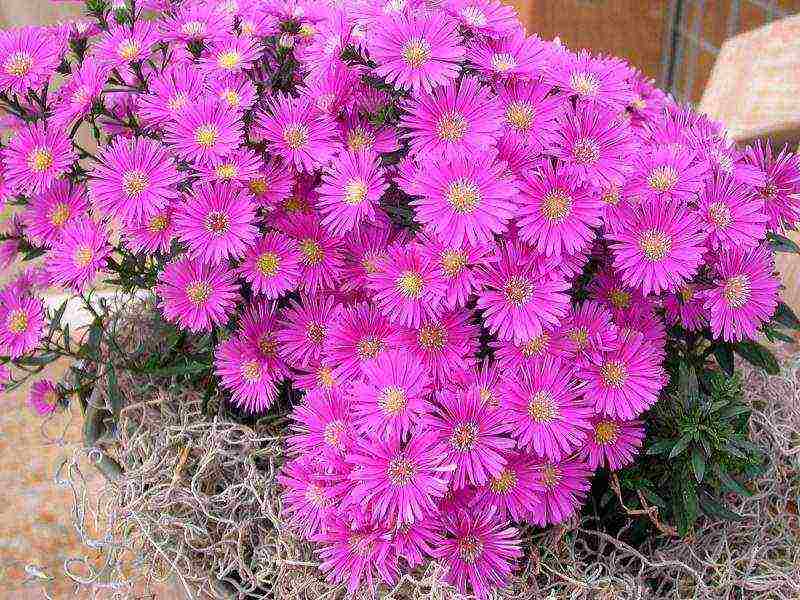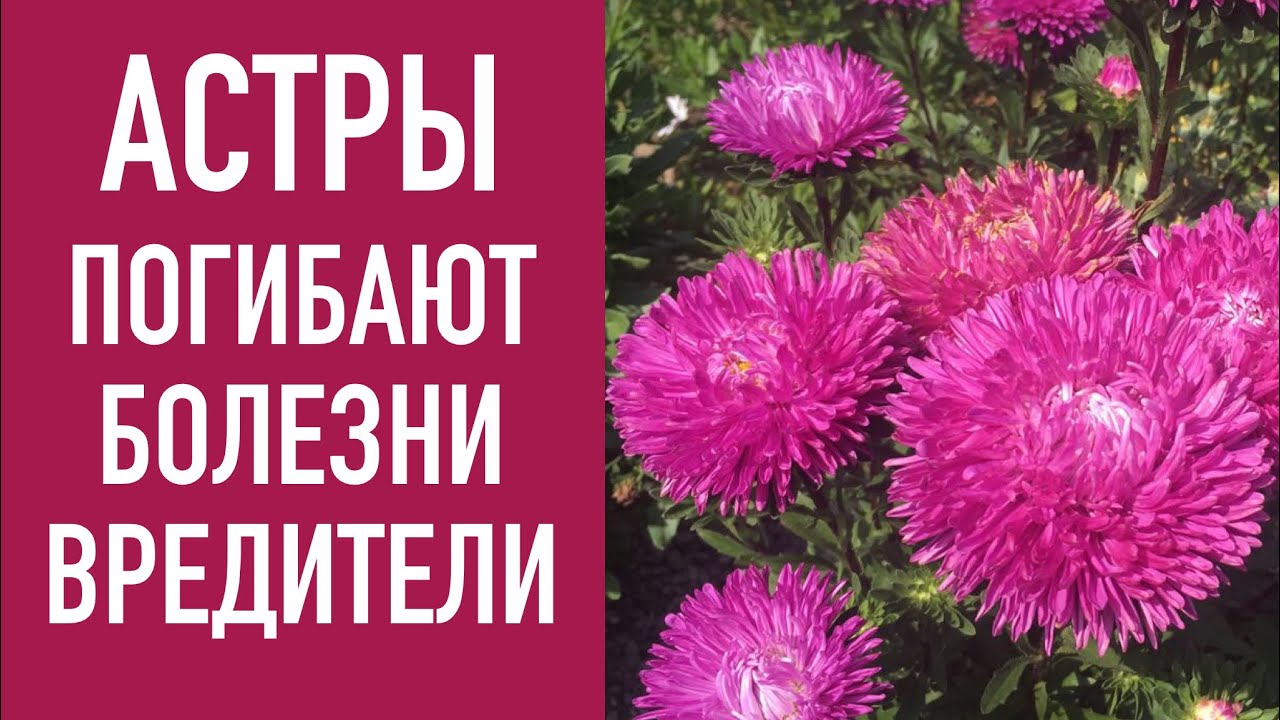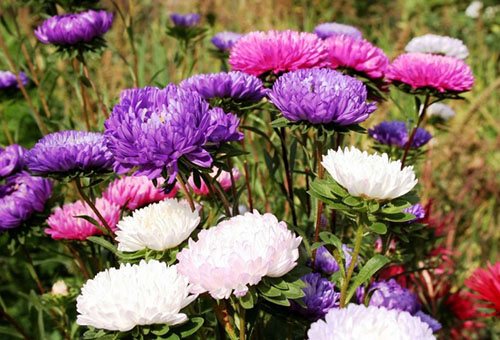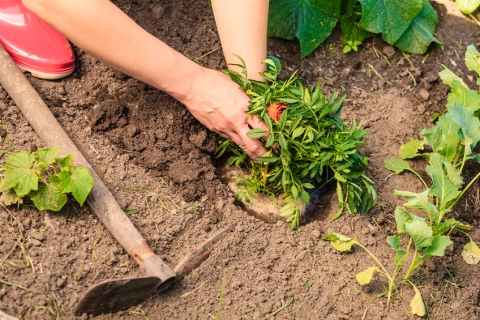Ways to fight
If you see that the plant has withered, it dies in the open field, then you need to urgently look for the cause, otherwise the disease will spread further to neighboring crops. Only a correct understanding of the cause of the disease will make it possible to draw up an effective treatment plan.
Many fungal diseases are treated with good fungicides.
However, each case has its own characteristics.
- Fusarium disease is easier to prevent than to cure. To do this, asters are not planted on the same site all the time; every 4 years you need to alternate with other crops. Before planting, the seeds are soaked in Fundazole, the soil is steamed and lime. For preventive spraying, copper oxychloride is used. If the plant does get sick, the diseased specimens must be destroyed.
- If plants are found infected with blackleg, they will also have to be removed. The rest of the seedlings can be treated with potassium permanganate, as well as onion infusion. To prevent the disease from attacking the plants, you need to be careful even at the picking stage. Plant the seedlings in disinfected soil.
- When late blight appears, it is necessary to cut off the diseased parts with a sharp and sterile pruning shears. The appeared wounds are covered with activated carbon powder. After a couple of hours, both the plants and the soil are treated with fungicides.
- At the initial stage of powdery mildew, plants are treated with a soapy solution; onion or tobacco tincture also gives good results. In more advanced cases, the culture will need to be treated with a solution of copper sulfate.
- As soon as rust has been noticed, all diseased parts are immediately cut off. Then it is recommended to treat the plant with powerful fungicides, they also need to be watered the soil. However, the disease can be avoided, for this you simply do not need to plant coniferous crops nearby.
- As for septoria, here the infected parts are also disposed of by pruning. Then, 2 times a month, the plants need to be treated with Bordeaux liquid.
- The fight against the carriers themselves - aphids - will help prevent the appearance of jaundice. To get rid of it, you need to brew 800 grams of yarrow in a bucket of water and boil for a couple of hours. Spraying is carried out with the cooled broth. At the same time, the affected specimens are discarded, burning them outside the site.
- Bacterial spotting is well treated by creating a dry environment. In order for the disease to slow down development, the plant should not be temporarily watered. The soil is disinfected with manganese, and the plants themselves are sprayed with copper sulfate every 3 weeks.
As for pests, at the initial stage, they can be successfully dealt with with soapy water. In addition, some gardeners practice manual collection, but this is relevant only for insects visible to the eye, you cannot collect a tick in this way.
If pests have already flooded the garden, it is recommended to use insecticides, they are different for each type of insect.
For example, "Karbofos" is suitable against ticks, and "Fitoverm" is suitable against thrips.
2 Options for helping plants
Of course, it is better to fully take care of the asters initially than to carry out medical measures later. Moreover, most diseases lead to the death of the plant. Nevertheless, the timely implementation of the recommendations listed below will allow you to preserve and improve ornamental bushes.
| Disease | Control methods |
|---|---|
| Jaundice | To save the asters, you need to remove all the affected parts, and treat the plants with an insecticide. This will get rid of the pests. Diseased bushes need to be dug up and destroyed to prevent the spread of infection. |
| Septoriasis | When the first signs of the plant appear, spray with a solution of Bordeaux liquid (100 g) or copper oxychloride (50 g), diluted in 10 liters of water. |
| Blackleg | It is necessary to disinfect the soil with fungicides or a concentrated solution of potassium permanganate and only then sow the seeds. Seedlings need to be watered infrequently as the top layer dries. At the same time, loosen the soil in order to ventilate the root system. Remove the affected bushes, sprinkle the ground with ash, reduce watering as much as possible. If the disease spreads quickly, transplant healthy plants to another place. |
| Rust | Spray the bushes daily for 10 days with a solution of Bordeaux liquid. Treat with a mixture of ground sulfur and lime. When planting, choose areas that are far from coniferous trees. |
| Fusarium | For cultivation, select resistant varieties of asters and monitor the conditions, follow the rules of agricultural technology. In autumn, burn off plant residues, drain the soil and neutralize the increased acidity with lime. In case of damage, remove diseased bushes, and treat healthy bushes with a solution of foundationol. |
| Leaf curl | You can get rid of the pest with the help of a decoction of tomato stepsons (boil 4 kg of green mass for half an hour). Dilute 3 liters of concentrate in 10 liters of water, add 40 g of shavings of laundry soap. Remove large accumulations of insects by chemical treatment. |
| Spotting | It is required to dig up the soil with a seam turnover and collect seeds from healthy specimens. When the first signs appear, you need to spray the bushes with a 1% solution of the Bordeaux mixture or 0.5% copper oxychloride. Carry out the processing 2-3 times with an interval of 10-12 days. |
How to recognize fusarium?
Darkening of the trunk and wilting of leaves are signals that the plant is sick with fusarium:
- leaves change color from green to yellow, and then to brown;
- leaves curl and wither;
- long brown spots appear on the stems;
- the root zone is covered with dark stripes;
- the formation of ruptures of the stem and, as a result, cracks is possible;
- aster stops developing and fades;
- at the bottom of the stem there are pink pads, or raids - myceliums.
The disease mows only annual asters, without infecting other representatives of the flora. Most of all, American Beauty is susceptible to fusarium.

Crops are infected with Fusarium at high humidity and temperatures above + 12 ° C. The temperature range + 20… + 27 ° C is favorable for the fungus. In unfavorable conditions, the fungus stops developing, and the symptoms of fusarium do not appear.
To prevent the disease, preventive measures must be observed: alternating crops in crop rotation with the return of asters to the site no earlier than 5 years later, neutralizing excess soil acidity with lime, seed treatment (for example, with topsin), steaming the soil before sowing or dressing it (ditan M-45 ), after planting, regular spraying of seedlings with fungicides, removal of diseased seedlings.
Another disease of asters is the black leg. This is a fungal infection, manifested in the blackening of the seedlings, followed by rotting of the stem, the death of the plant. Prevention includes early picking of seedlings, preparing the soil for planting - processing with potassium permanganate, dusting the seedlings with sand. You can destroy the fungus by watering the soil with onion infusion 2 times a day (about 20 g per 1 liter of water).
Aster rust is a fungal infection that affects even pine trees. Its symptom is swelling or pustules at the base of the leaves that appear in June-July, filled with fungal spores. During the course of the disease, the leaves dry out. The onset of the disease is also possible in the autumn - in the form of orange pads. The needles get sick in the spring, by the summer the spores from the cushions of the pines scatter and are carried by the wind even over long distances, affecting the aster leaves.
Treatment of asters with crushed sulfur with lime (1: 1) at a temperature of + 18 ... + 20 ° C, the use of Bordeaux liquid (once a decade), planting plants no closer than 300 m from coniferous plantations will save them from death.
Perennial asters are susceptible to a fungal disease known as powdery mildew. It infects leaves and stems in the second half of summer. The white, cobweb-like coating contains spores. The diseased leaves dry up. The neglected plantings of perennial asters receive the greatest harm, since the fungus is easily transferred from plant to plant, hibernates on dead leaves.
For the healing of plants, you must:
- cut off and destroy the entire aerial part of diseased plants in the fall;
- observe an isolation regime, preventing the transfer of the disease;
- to carry out chemical treatment with colloidal sulfur (100 g per 10 l of water), soda ash (50 g per 10 l of water) at least twice in August with an interval of ten days.
Almost all fungal diseases (namely, they are most often found in asters) require treatment and preventive spraying with fungicides, thinning of crops, tillage before planting, seed dressing.

Causes of occurrence
Disease is a common occurrence among asters. Typically, a culture is affected by three types of diseases: viral, bacterial and fungal.
The viral ones are the most dangerous because there is often no cure for them in general.
Such types of ailments are transferred from flower to flower by pests, and they may well fly in from neighboring areas. Another reason for the appearance is contaminated seed. That is, the seeds that the gardener bought are already initially infected with viruses. In addition, there are situations when plants have already died once after a disease, and the land has not been properly cultivated. Then, with a high degree of probability, the virus will attack the culture again.
Bacterial diseases are not so common, but they are also difficult to treat. Bacteria can get into asters in several cases:
- through infected tools;
- in the absence of treatment and disinfection of the plant after pruning, as well as if the branches or stem are damaged.
The most common type of diseases is fungal, and this applies not only to asters, but also to all crops on the site as a whole.
Consider a number of reasons why such diseases appear.
- Failure to comply with the watering regime. Every gardener knows that any plant needs to provide its own watering regime. Astra needs a lot of water, but this does not mean that it needs to be filled. If there is an excess of water, this will be an excellent "starting point" for the development of the fungus.
- High air humidity. The fungus loves moisture and reproduces fastest in rainy summers.
- Too dense planting. When there are too many plants in one area, they begin to "compete" for nutrients in the soil. In addition, some parts of the culture will not have enough sun, as well as oxygen, since air circulation will be disturbed. In such conditions, the appearance of the fungus is very predictable.
It is worth noting that the above reasons do not always necessarily cause the appearance of the fungus.
However, it must be remembered that spores are most successful at attacking weak plants with poor immunity.
If you do not take good care of your pets, do not water properly, do not know what and how to feed, diseases in most cases cannot be avoided.
1 Reasons for the appearance of yellow dried leaves in asters
Asters are popular with gardeners for their unpretentiousness and beautiful flowering. Breeders are constantly working on the development of new varieties. Today, you can grow annual and perennial plants, which are distinguished by the richness of colors, flower sizes, and the shape of the petals. Ornamental bushes are planted in flower beds, mixboards, alpine slides. Some people decorate balconies and boxes with them.

Another reason for the development of diseases is the violation of the agricultural technology of flowers.Violation of the rules of agricultural technology makes plants weaker and more vulnerable. Flowers do not like excessively moist soil, which is inevitable with frequent watering or rainy weather. Pest insects are also capable of causing irreparable harm to asters, and often lead to their death.
The main pests, methods of dealing with them
Home aster disease can be avoided due to improved living conditions. In addition to diseases, garden species are constantly threatened by various pests.
Spider mite
Insect pest representative of the spider family. It is not difficult to notice it. In clusters, it forms yellowish-green, red or orange dots on the leaves. Although the length of one insect is one millimeter.
Ticks settle on the underside of the foliage, sucking the juices out of it, covering the hatched places with cobwebs.
Mites are destroyed by pollination of plants. For this, ground sulfur is used. You can spray the bushes with a solution of karbofos, having previously studied the instructions.
Common earwig
This pest belongs to the leatherwing family. It has an oblong brown body. The earwig is 12-17 millimeters long. You can also spot an insect by its long mustache.
Important! The main feature of the earwig is that it loves to act at night, and hides in the light. The harm caused by this type of pest consists in gnawing leaves, stems, buds and flowers
Asters captured by an ordinary earwig, receiving severe damage, lose their decorative effect. In some cases, plants die
The harm caused by this type of pest consists in gnawing leaves, stems, buds and flowers. Asters captured by an ordinary earwig, receiving severe damage, lose their decorative effect. In some cases, the plants die.
They fight earwigs by removing weeds and loosening the soil. In addition, the bushes are watered with potassium permanganate and sprayed with insecticide. Such processes are performed several times a month.
Aster blizzard
She flies around flowers. It looks like a small light butterfly with dots on its wings. The caterpillars from which these butterflies are made eat the flower petals.
They act as follows against the aster snowstorm. Before planting flowers, the soil is cultivated with Bazudin. Pests that have already appeared are removed manually.
Aphid kidney
This pest likes young asters. Its presence can be seen by deformed leaves of plants, wrinkled surface of leaves, falling off.
Kidney aphids are destroyed by spraying the bushes with karbofos three times.
Plowed slug
Naked gastropods. It has a smooth grayish-yellow body. The length of the garden pest is 5 centimeters. He loves to eat foliage and flowers. It spreads most strongly in warm and humid weather.
Slobbering penny
For habitation, it chooses foamy secretions that form the axils of shoots and leaves. Deformation of stems and leaves occurs, on the surface of which yellow spots appear additionally.
Pest control methods include spraying and treating the bushes with the compositions indicated in the examples of other pests.
Aphid helihrix
Deforms the leaves of flowers, harms the sprout buds and often peduncles.
Having found aphids on asters, the plants are sprayed with karbofos or depis. You can also help with chlorophos. For processing, choose early spring, when the plant only has foliage and its number is few (about 4 leaves).

Slobbering penny
How to protect asters from pests
Cucumber mosaic
The causative agent of the mosaic is carried by aphids or leafhoppers. In mosaic, young leaves are deformed, small with light veins, which then completely brighten. The main stem has short internodes, the aster does not bloom or the inflorescences are ugly and one-sided. The pathogen persists on the roots of any crops and weeds.
Mosaic protection. But it does not exist, so diseased asters are destroyed immediately. Pests carrying pathogens should be dealt with.
Aphids can severely damage crops. It multiplies rapidly in dry and hot weather, forming entire colonies on stems and foliage, sucking out the juice. Plants infected with aphids lag behind in growth, deform, flower petals discolor and curl, and then dry out.
Remedies. In case of mass infection, Inta-vir preparations are used (a 10-liter tablet) with the addition of laundry soap for better adhesion of the solution to the foliage.
A small settlement of aphids can be treated with a folk remedy - a decoction of tomato stepchildren. To prepare it, you need 4.0 kg of tomato greens per bucket. All are boiled for about 30 minutes, filtered, cooled. To process asters, you will need a decoction of 3 liters, 40 g of crushed household soap and bring up to 10 liters with water.
So we got acquainted with how to protect asters from diseases and pests. Be attentive to the condition of the plants, follow the rules of crop rotation, do not plant weeds on the site and destroy pests-vectors of diseases in time. Then asters will delight you with abundant and lush flowering until late autumn.
If you find an error, please select a piece of text and press Ctrl + Enter.
Overview of diseases
Now that the reasons for the appearance of different types of diseases are clear, it is worthwhile to learn more about the description and symptoms of the most common ailments of asters.
Fusarium
The second name of the disease is fusarium wilting. It is provoked by Fusarium - a special fungus that is located in the ground. If plants are planted on infected soil, the fungus will begin to spread, penetrating the asters through the roots.

The main symptoms are:
- leaves turn yellow, then turn brown, dry up and curl;
- strange brown spots appear on the stems, the stem itself is capable of cracking;
- asters dry on the vine;
- below on the stem you can see pink fluffy growths - these are Fusarium spores.


Blackleg
This is another fungal disease, the development of which is most often noticeable even at the seedling stage. The disease is quite dangerous, young seedlings die from it in just a couple of days.
Signs:
- black areas appear on the stem;
- the base of the plant begins to rot;
- the stalk becomes thin and weak, lies on the ground.


Late blight
A very common disease among horticultural crops. It can easily affect not only asters, but all nearby plants.
Its symptoms:
- brown spots appear on the leaves and stem, which look like mold;
- the plant has a strange, cobweb-like bloom.

Powdery mildew
This is one of the diseases that often become a "headache" for the gardener. It occurs in high humidity conditions.
Defined as follows:
- white bloom appears on the asters, which leads to the fact that individual parts of the plant quickly disappear;
- the leaves begin to rapidly turn yellow and wither, they hang lifelessly along the stem;
- flowers are deformed, lose their appearance and color.


Rust
This is an ailment that is also caused by a fungus, and most often this "raider" comes from coniferous crops.
Symptoms:
- at the bottom of the sheet, you can see brown hollow specks - these are pustules, which will soon serve as a place for the accumulation of spores (in the future, the pustule opens on its own, and the spores fall into the ground);
- leaves shriveled, curly, become lethargic and weak, die off quickly.

Brown spot
In another way, this disease is called septoria. Fungal pathogens of the disease love hot and humid weather, in such conditions they rapidly infect asters.
Signs of illness:
- light brown spots begin to form on the foliage, which quickly spread over the entire surface;
- the bush itself takes on an unsightly appearance - it withers, dries, the leaves curl, crumble.

Jaundice
This is one of the viral diseases. Its main carrier is aphids.
Symptoms:
- leaves brighten, then begin to die off;
- the buds turn green, stop growing.

Bacterial spot
The most dangerous disease, the carriers of which calmly winter in the soil and fallen leaves. It begins to spread during the rainy season.
Signs:
- large spots of yellow or light brown hue appear on the leaves;
- then, if you do not take action, the foliage curls and quickly falls off, the bush dies.

Rot
There are several types of rot, but in most cases, the aster is affected by gray. This is a serious bacterial disease that has killed many horticultural crops.
Symptoms:
- the plant turns brown, and absolutely all of its parts;
- rotting of the bush is observed;
- aster is covered with a gray bloom.

Speaking about diseases of culture, one cannot fail to mention the fact that pests often attack it.
Earwig
A nocturnal insect, well recognizable by its long antennae, as well as a pliers-like tail. It devours all parts of the plant, leading to death.

Meadow bug
A tiny, but no less dangerous pest from this, moves through the air. It sucks the juice out of the plant, due to which the flowers and leaves lose their shape, the bush is deformed.

Spider mite
The insect does not disdain anything that is on the site, including asters. It feeds on plant sap, covering them with its thinnest cobweb.


Aphid
A small pest that most often prefers young seedlings. Easily recognizable by slippery and sticky shiny tracks. Over time, it eats up the leaves.

Thrips
Small insects, almost invisible to the eye. They feed on sap, and also successfully transfer diseases from plant to plant. Their appearance is characterized by white and yellow spots on the leaves, the buds become ugly, the aster stops growing.

Aster flower, disease
Blackleg
This is a very common disease. It affects not only flowers, but all plants, especially seedlings and young seedlings. Blackfoot fungus lives in the soil. In the affected seedlings, the stem turns black and thinner at the base, the plant itself quickly falls and dies. The disease spreads quickly and all seedlings can die in 2-3 days. The spread of the disease is facilitated by high humidity and dense crops.
Protection methods. For preventive purposes, the soil must be shed with a dark solution of potassium permanganate or another fungicide against fungal diseases. In addition, asters should be watered sparingly and only when the soil dries up, and you should also not plant densely plants so that they are well ventilated.
Diseased plants should be removed with a lump of earth, and healthy plants should be transplanted into new soil.
Fusarium
This is a very dangerous fungal disease that causes a lot of damage to crops and is widespread. Crops can get sick at any time, but more often it manifests itself during the period of bud formation and flowering. The Fusarium fungus is activated at a temperature of 20-27 degrees and first affects the root system, and then the aster stem, on which longitudinal brown stripes appear. Diseased plants turn brown and dry out. A dangerous disease can destroy up to 80% of plantings.
The spread of the fungus is facilitated by the introduction of fresh manure, acidic soil, the formation of a crust on the surface of the earth, dense planting, delayed removal of diseased plants.
Protective measures. There are no aster varieties resistant to fusarium. Therefore, you should not leave plant residues in the fall, in which the fungus hibernates. You also need to periodically liming the soil and perform drainage in places of stagnant water.
If a symptom of a disease is detected, the plants are immediately removed, and all other plantings are treated with Fundazol (20 g per bucket), processing rate: bucket / sq. m. Repeat the treatment after 10 days at least 5 times.
Septoriasis
The disease is also called brown leaf spot. More often it appears on the lower leaves during the budding period. Brownish spots appear on the foliage, which quickly capture new leaves. Affected foliage dries up when the aster blooms.Warm and humid weather, dense planting, and an excess of nitrogen in the soil contribute to the spread. The Septoria fungus also survives on plant debris.
Method of protection. If a disease is detected and for prevention, planting should be treated at least 2-3 times with a frequency of 12-14 days with preparations containing copper: Bordeaux liquid (100g / 10 l) or copper oxychloride (50 g / 10 l).
Gray rot
It affects not only the aster, but also other cultures. Stalks, foliage, flowers suffer from it, it is especially dangerous for young plants. When infected, the leaves and stems first turn brown and rot. The disease manifests itself more often in rainy, cool summers.
Protection measures against gray rot are the same as for septoria (brown spot).
Bacterial spot
Disease is caused by bacteria. Most often it appears during the formation of buds and spreads rapidly during flowering. First, the leaves from the underside, stems, buds are affected. Small oily spots up to two cm appear on them. Over time, the spots expand, capturing the top of the leaf, penetrate the seeds, so they do not collect seeds from diseased plants.
Protective measures. Treatment for prevention and treatment is carried out with preparations containing copper: copper oxychloride (0.5%), Bordeaux mixture (1%) 2-3 times per season with an interval of two weeks.
Experienced flower growers recommend planting asters in places where plant residues are burned, where the fungi are destroyed by fire.
Why do lilac leaves curl
Lilacs do not require much maintenance. But recently, this unpretentious shrub has become more likely to be exposed to various diseases. One of them is called "leaf rolling". The disease is caused by a special virus transmitted by ticks. In this case, the leaves become brittle and turn yellow, and only their edges are deformed.
Lilacs and pests do no less harm. To understand the problem, we have compiled a small table, which describes the common causes and methods of struggle.
| Cause | Control measures |
| Lack of nutrition or exposure to frost (the plant forms a large crown, but the roots are underdeveloped) | Feed the bushes with mullein infusion (1:10). Per plant - 1-3 buckets. |
| Mosaic (small yellow spots appear first; leaves curl even with severe damage) | Cut and burn diseased branches, and if necessary, the entire bush. |
| Damage by pests: speckled moths, scale insects | During the growing season, regularly remove twisted leaves with caterpillars and pupae, treat the bushes with insecticides (Fitoverm, Fufanon, etc.) |
Why lilacs don't bloom - all possible reasons and what to do
Helpful tips on how to save lilacs in your garden.




